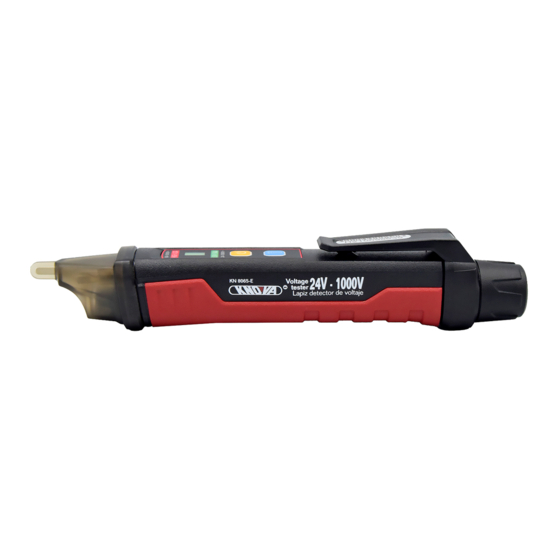
Publicidad
Idiomas disponibles
Idiomas disponibles
Enlaces rápidos
24V - 1000V
Voltage
tester
Lápiz detector de voltaje
ENGLISH
Preface
Thank you for purchasing the new voltage detector. In order to use
this product safely and correctly, please read this manual thoroughly,
especially the Warning part.
After reading this manual, it is recommended to keep the manual at
an easily accessible place, preferably close to the device, for future
reference.
Overview
The KN 8065 series products are non-contact voltage detectors with
built-in flashlight and acousto-optic synchronous alarm function.
The CAT IV 1000V safety class ensures users' safety, making them
essential tools for industry and home.
Low voltage mode (24V AC ~ 1000V AC)
(KN 8065-E only):
Suitable for testing low-voltage motor (< 90V), audio systems,
arc welding machines, underground mine lighting, cables with thick
insulation layer, and other weak electromagnetic AC signals.
High voltage mode (90V AC ~ 1000V AC):
For detecting urban electric supply and three-phase systems.
For example, power distribution units, electrical panels,
electrical appliances.
KN 8065-E
2. Please test the detector on a known live source within the rated
3. If the detector appears damaged or is not working properly, stop
4. Do not detect voltage higher than 1000V.
5. Use caution when working with voltages above AC 30Vr.m.s,
6. There may still be voltage even when no acousto-optic alarm is on.
7. The insulation type, wire thickness, distance from voltage source,
8. Do not assume neutral or ground wire is safe to touch. Incorrect
9. When low battery indication appears, please replace the batteries.
90V - 1000V
Voltage
tester
Lápiz detector de voltaje
WARNING
1. Please carefully read and fully understand the warnings and
operating instructions before use. If the equipment is used in
a manner not specified by the manufacturer, the protection
provided by the equipment may be impaired.
AC voltage range before use.
using it immediately.
42V peak or DC 60V. Such voltages pose a shock hazard.
Clean the tester casing with a damp cloth and mild detergent.
Do not use abrasives or solvents!
shielded wire, other wires, socket design, and other factors may
adversely affect test result. If there are uncertainties, use other
methods to verify the voltage.
or poorly connected circuits may cause wires to be charged.
KN 8065-S
Publicidad

Resumen de contenidos para KNOVA KN 8065-E
- Página 1 Low voltage mode (24V AC ~ 1000V AC) 6. There may still be voltage even when no acousto-optic alarm is on. (KN 8065-E only): 7. The insulation type, wire thickness, distance from voltage source, Suitable for testing low-voltage motor (< 90V), audio systems,...
- Página 2 12. The detector will not detect any voltage if: In vibration mode, when strong signals are detected, there will also • The wire is shielded be vibration alarm (KN 8065-E only). • The operator is not connected with the ground or isolated from an effective ground Note: Please unplug other electrical devices on the socket before detection.
- Página 3 En el modo de vibración, cuando se detectan señales fuertes, • El voltaje es DC también habrá alarma de vibración (solo KN 8065-E). 13. Es posible que el detector no detecte ningún voltaje si: Nota: Desenchufe otros dispositivos eléctricos de la toma antes •...
- Página 4 Cambio de batería ruidos eléctricos. Utilice únicamente el modo de bajo voltaje KN 8065-S: durante un entorno de campo eléctrico débil. (Solo KN 8065-E) 1. Sostenga el detector con una Nota: En el modo de detección de campo magnético, no se mano, use el pulgar de la otra puede detectar voltaje al mismo tiempo.